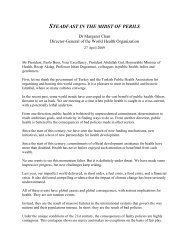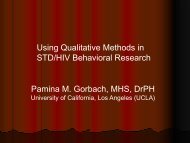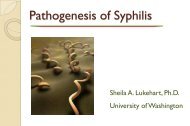The Evolution of HTA in Emerging Markets Health-Care ... - TREE
The Evolution of HTA in Emerging Markets Health-Care ... - TREE
The Evolution of HTA in Emerging Markets Health-Care ... - TREE
You also want an ePaper? Increase the reach of your titles
YUMPU automatically turns print PDFs into web optimized ePapers that Google loves.
OHE Consult<strong>in</strong>g Report for PhRMA<br />
5 January 2011<br />
Figure 3. Taiwan Drug Review Process<br />
A3.7 Pric<strong>in</strong>g <strong>of</strong> New Drugs<br />
Doherty, et al. (2004) note that there are, at least, three methods used to determ<strong>in</strong>e the price <strong>of</strong><br />
new pharmaceuticals: (1) the <strong>in</strong>ternational median price <strong>of</strong> 10 countries, (2) the <strong>in</strong>ternational price<br />
ratio us<strong>in</strong>g treatment comparators and (3) the treatment course or daily cost us<strong>in</strong>g treatment<br />
comparators. Advantages or disadvantages <strong>of</strong> new products, along the dimensions <strong>of</strong> efficacy,<br />
dosage form and pharmacok<strong>in</strong>etic pr<strong>of</strong>ile, are considered <strong>in</strong> decisions to <strong>in</strong>crease or reduce price.<br />
Pharmaceutical companies provide evidence to experts <strong>in</strong>vited by the BNHI and a drug benefit<br />
committee. Evidence from RCTs are required (with preference for head-‐to-‐head comparisons <strong>of</strong><br />
efficacy and safety) whilst submission <strong>of</strong> pharmacoeconomic evidence is encouraged <strong>in</strong> 2008.<br />
In 2010, a new “Pric<strong>in</strong>g Pr<strong>in</strong>ciples” document was issued by the Bureau <strong>of</strong> National <strong>Health</strong> Insurance<br />
(BNHI, 2010). A dist<strong>in</strong>ction is made between Category I and Category II new drugs, and the<br />
reference pric<strong>in</strong>g benchmarks and pric<strong>in</strong>g rules are different for the two categories. For a new drug<br />
to be <strong>in</strong> Category I, drug license holders must justify a “substantial cl<strong>in</strong>ical improvement” via head-to-‐head<br />
or <strong>in</strong>direct comparison. Category 2A new drugs exhibit at “moderate improvement, while<br />
Category 2B new drugs have similar cl<strong>in</strong>ical outcomes as therapeutic reference class products.<br />
Category I drugs are priced (i.e., reimbursed) at the median <strong>of</strong> 10 reference countries (with a 10%<br />
premium if a Taiwanese trial <strong>of</strong> a reasonable scale has been done). <strong>The</strong> pric<strong>in</strong>g <strong>of</strong> Category II drugs<br />
100








